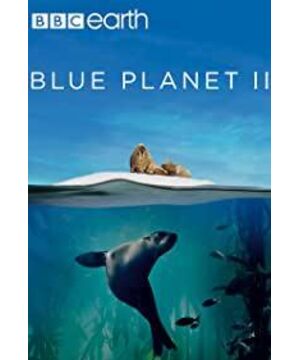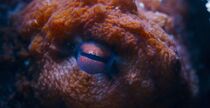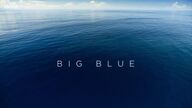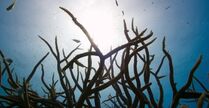l Introduction
"Blue Planet 2" is hosted by Sir David Attenborough. During the 4 years of shooting, the production team carried out 125 expeditions, and the underwater shooting time reached more than 6000 hours. After 16 years of "Blue Planet", which premiered in 2001, the production team used new technology to break through the limitations of the past, presenting many unknown areas in the past, amazing creatures and their jaw-dropping actions to the audience.
From the polar bear-infested Arctic Ocean to the vibrant blue coral atolls, this series of documentaries share some surprising new discoveries with you; encounter strange octopuses appearing in the depths of the Southern Ocean, and watch giant trevally jump out of the water. , Leap into the air to fish; riding on the back of the killer whale, rush to the school of fish with it. "Blue Planet 2" leads us to experience awe-inspiring new places, see glamorous new species, and understand extraordinary new behaviors.
l Notes
Episode 1 One Ocean
Embark on a journey from the tropics to the frozen extreme of the planet. Life has spread to almost every part of the ocean, but there are many different worlds, each of which presents unique challenges. In the tropics, dolphins chase pure happiness. Baby dolphins learn to rub a certain coral, because this coral will give dolphins a protective film, people can consider extracting medicine from this coral. Giant trevally jumped out of the water to hunt birds. In temperate waters, the rays of manta rays create a fascinating night view, and when microbes glow, they will be hit by them. Two kinds of pseudo killer whales and bottlenose dolphins come together to form a powerful camp. A sea bream that automatically converts, always needs to beware of its own "harem". Our ocean system is changing. In the northern polar regions, summer sea ice has fallen by 40% in the past 30 years, causing a profound impact on wildlife, including walruses.
1. Eastern Cape, South Africa: Indo-Pacific bottlenose dolphins surfing show.
2. Egyptian Red Sea: Bottlenose dolphins rub their bodies over sea fans to prevent bacteria.
3. Australia's Great Barrier Reef: Hogtooth uses the hard coral reef as a tool to smash clam shells to eat meat.
4. Indian Ocean Seychelles: The rare trevally jumps out of the water to prey on the young birds of the tern.
5. The Sea of Cortez, Mexico: Manta rays prey on plankton to make them emit biological light.
6. New Zealand: Cross-species communication between false killer whales and bottlenose dolphins.
7. Offshore in northern Japan: The female of golden headfish grows to a certain length and becomes a male who competes with the original male leader for territory and spouse.
8. Northern Norwegian fjords: Killer whales cooperate to hunt herring by carousel, while humpback whales cooperate to catch herring by air curtain fishing.
9. Svalbard Island, Norway: Atlantic walruses struggle to choose a habitat for their cubs to rest while avoiding polar bears.
Episode 2The Deep
The deep sea takes people on an epic journey of an unknown world, a broken, cruel cold and dark world. This is the largest living space on the planet. Scientists believe that there is more life here than anywhere else on the planet. This is the last frontier for people. People discover alien worlds and strange creatures. A group of fierce squids hunted in the depths. The coral garden thrived in the darkness. The carcass of a whale becomes a good meal for sharks, worms that feed on bones; shrimps living in crystal sponge cages. As people continue to go deeper, the sheer weight of the water creates unbearable pressure. However, even at a place eight kilometers deep in the ocean, the basic chemistry of life was once considered impossible, but people have discovered some strange new species in the dark. In volcanic hotspots, the micro-world blooms in life. The creatures living here are as strange as the world they live in. Hair-covered crabs feed on spitting out hydrogen sulfide; shrimp linger on clouds of chemicals, hot enough to melt lead.
1. Antarctic Peninsula: octopus, feather star, Antarctic krill and other creatures make up the colorful world of Antarctic waters under one kilometer.
2. Portugal, Azores: The fall of the sperm whale carcass allows six gill sharks, sheath fish, spider crabs, toothed rock crabs, zombie worms and other scavengers to gather to form a temporary oasis.
3. Chile: Red squid hunts lantern fish in the deep sea.
4. Galapagos, Ecuador: Swordfish in the deep sea. Li prawns that live a lifetime in the sponges of the same cave with A's brother.
5. The United States, the Atlantic coast: many deep-sea creatures-cross-eyed squid, Pacific backfish, angling, fang fish, lantern fish, pipe jellyfish, pelagic sea cucumber, giant mouth fish, pancake octopus, giant pipe worm.
6. The United States, Pacific Coast: Many deep-sea creatures-bioluminescent shrimps, gill eels, single spiny fish.
7. Pacific Ocean, Mariana Trench: Animals that live in the deepest waters in the world-ethereal lionfish, sea pigs, starfish, and worms.
8. Atlantic Ocean: Bacteria brought by the hot springs under the sea make the white mouth, deep sea lobster (Hoff crab) and other creatures survive.
9. Australia: The huge size of the fire body worm dwarfs the ocean whitetip shark.
Episode 3 Coral Reefs
Coral reefs are home to a quarter of marine species. Surviving in these submarine cities is a challenge, and there are many different solutions. A sea turtle goes to rest on the reef, which is equivalent to a health spa, but she must drive away other competitors. A striking grouper cooperates with an octopus to flush prey from a hidden cave. During super macro shooting, coral polyps grow and die, laying the foundation for the structures that people see from space. Whirlpools, tides and caves generate electricity. As night fell, sharks gathered one after another, and the spawning behavior of groupers attracted them. Rising temperatures have led to the most destructive coral bleaching event in history. But there is still hope. People have witnessed one of the largest spawning events in the ocean: a blizzard released by corals, fish and invertebrates in one night.
1. Egypt, Red Sea: The coral throwing game of bottlenose dolphins.
2. Borneo: Turtle rock fish therapy for green sea turtles. Saddleback clownfish cooperate to carry coconut shells and female fish spawn. Parrotfish feed on the algae on the corals, and their excrement forms sand.
3. Australia, Great Barrier Reef: Cooperated with octopus for fishing. Various coral forms. Coral bleaching event.
4. Indonesia: The white spotted squid hypnotizes the crab and preys on it by changing its skin color and shape. Bobitworms under the sand on the seabed prey on lionfish and sea bream at night.
5. Maldives: Manta ray's cyclone method filters plankton.
6. French Polynesia: The group of leather scales lay eggs, and the black-tailed sharks will take advantage of the situation to prey.
7. Philippines: Various coral forms.
8. Bahamas: The vortex formed when the tide passes by will trap a variety of reef fish and invertebrates.
Episode 4The Ocean (Big Blue)
The ocean is a large blue desert, far from the coast, with almost nothing to eat, and home to some of the largest and most spectacular creatures on the planet. With a special pressure camera, people have witnessed record-breaking endurance. Sperm whales are looking for squid one kilometer in the abyss. Until recently, no one knew how sea turtles survived the vast ocean. The big blue shows that they reached the center of the ocean, where they used floating debris as a life raft. The Portuguese battleship jellyfish harnessed the power of sail to fish. The unique aerial footage reveals an ancient legend. The whale shark made an epic voyage in the Pacific Ocean, and scientists now believe that this may be the safest way to give birth. A pair of aging albatross adds the last birdies to their lives. However, even if it is thousands of kilometers away from the land, there is evidence of human activity. Global ocean currents bring plastic to the center of every ocean, often with tragic consequences. For the creatures of the blue giant, plastic is a challenge.
1. Global open waters: Sperm whales cooperate with their families to hunt squid in the deep sea to feed their cubs.
2. Costa Rica, Eastern tropical Pacific: Lantern fish collectively lay eggs on the sea, attracting predators such as long-nose dolphins, manta rays, sailfish, yellowfin tuna, etc., forming a boiling ocean.
3. The Canary Islands. Borneo. Bahamas. Costa rica. Scotland. Arctic. Global (Atlantic and Pacific): The yellow rubber ducks drifting on the sea for many years, let us realize the global distribution of ocean currents.
4. Pacific Ocean: Floating objects in the high seas will become homes for the growth of moon jellyfish, sea nettles, juvenile hawksbill turtles, juvenile green sea turtles, and juvenile silk sharks.
5. Atlantic coast, Canary Islands: The mitral jellyfish prey on its prey by being highly venomous. The short-fin pilot whale mourns the dead cub. Loggerhead turtles were entangled in plastic in the ocean and drowned.
6. Azores: Atlantic grouper fish in the waters contaminated by plastic.
7. Atlantic Ocean: Great blue sharks use their sense of smell to find carrion in the ocean.
8. South Africa, Atlantic Ocean: Great white sharks bite dead whales.
9. Pacific Ocean, Galapagos: The secret birthplace of whale sharks.
10. South Georgia: The whole process of nurturing the offspring of the wandering albatross.
Episode 5 Green Seas
In a green ocean, competition is fierce. Sunlight makes vast seaweed forests, mangroves, seagrass grasslands and seaweed grow in great quantities. Here, animals must compete for space and food. In the kelp forest, the ordinary octopus must become the ultimate escape master to escape its natural enemy pajama shark. The sea urchins and sea otters plundered by the seaweed garden become impossible allies. On the seagrass prairie, tiger sharks and green turtles play a game of cat and mouse. This will keep the seaweed healthy. In the seaweed of the scrub meadow, a large group of spider crabs emerge from the abyss, molting their skins on a large scale every year. Try to avoid predation of stingrays, which can be up to four meters long. The male big squid competes for a mate, while the smaller male pretends to be a female. In mangroves, the mantis shrimp abandons its once-in-20-year mate for a larger female. Elsewhere, dolphins, whales, sea lions and birds compete for a feast. A huge group of plankton, eating fish attracted by tiny algae.
1. Australia, Victoria: The spawning of male grass sea dragons. Seagrass, the only flowering plant in the ocean, giant spider crabs come here once a year to shed their shells and grow up, and short-tailed stingrays take the opportunity to prey on spider crabs.
2. Western Australia: The hunting relationship between tiger sharks and green sea turtles will limit the overexploitation of seagrass.
3. South Australia: For the giant Australian squid to mate, some short males will disguise themselves as females and get close to the females for mating.
4. North Australia: Under the mangrove forest, the raid hunting of mantis shrimp, and the males will abandon the original match because of the attraction of larger females.
5. South Africa: Common octopus camouflages with shells to avoid hunting pajama sharks. At the same time, hana sharks, fur seals, bamboo kelp, and split fan kelp also live in this sea area.
6. United States, California: Anchovies gather because of phytoplankton, attracting hunting by predators such as common dolphins, California sea lions, and humpback whales. The American red damselfish protects its seaweed fields from being destroyed by crested sea urchins. At night, predators such as Pacific electric rays force it to escape. The sea otters above the macroalgae love to prey on sea urchins.
7. Norway: Sea stars, red sea cucumbers, brown sea cucumbers, sea gills and other creatures become active due to the early spring sunshine.
8. The Pacific coast of North America (Alaska, British Columbia, California): Red sea urchins, purple sea urchins, kelp, sea otters and other creatures are thriving.
9. Cuba: The American crocodile moves downstream.
Episode 6 Coasts (Coasts)
On the coast, two worlds collide. The coast is the home for the wild animals on this blue planet to survive in this ever-changing world. This is an epic drama where the heartbeat stops like a roller coaster, and the creatures range from beautiful to strange. Sixty kilograms of tuna swim too fast for sea lions, but the sea lions hunt as a team. The land crab jumped up from the rock, avoiding the sea as much as possible. The moray launched its own attack from the rock pool. The octopus will crawl in the rock in search of prey. After the 60-mile return flight, a puffin returned with a mouth full of food. In the Pacific Ocean, bizarre jumping slender fish are in small caves. Males try to attract mates, but the waves are their obstacles. These are fish that hate water. There are thousands of huge elephant seals, and they need to endure without food for a month.
1. Costa Rica: Li turtle swims to the coast to lay eggs.
2. United States, Florida: Shortfin sharks and blacktip sharks migrate to warm coastal shallow waters.
3. Ecuador, Galapagos Islands: Sea lions cooperate in hunting yellowfin tuna.
4. Canada, British Columbia: Time-lapse photography shows the competition of limpets, ochre starfish, brown algae, blue mussels, sea hares, sea scale insects, giant green anemones, common starfish, and barnacles in the pool after low tide .
5. Guam: The courtship of catfish, the most obvious terrestrial habit.
6. Norway: Arctic puffins and guillemots avoid the predation of Arctic skua to feed their cubs on their way back from foraging.
7. Brazil: Redstone crabs avoid the sniping of predators such as chain eels and octopuses on their way to foraging on rocks with seagrass after low tide.
8. South Africa: Throat fish prey on limpets.
9. Spain: The rock formations washed by the sea form a church-like arch structure.
10. Antarctica, South Georgia: Emperor penguins need to pass through the fat wall formed by elephant seals for an annual moult.
Episode 7Our Blue Planet
There is evidence that albatross parents inadvertently fed plastic to their little birds, female dolphins may expose newborns to pollutants through contaminated milk, and even artificial noise drowns the natural sounds used by animals to communicate. Many creatures are struggling to survive. Despite these destructive influences in the world, this movie gives people an inspiring message and hope. The herring that spawned in the spring in Norway fifty years ago was almost extinct. Hundreds of humpback whales and orcas gathered together for a feast. In the Caribbean, communities are working hard to protect animals. But some changes in the ocean will require global efforts: the warming ocean threatens huge coral reefs, and rising sea levels are expected to affect the lives of hundreds of millions of people around the world.
1. Galapagos Islands: Exploring the birthplace of whale sharks.
2. Norwegian northern fjords: The development of the fishing industry affected the hunting of herring by killer whales and humpback whales.
3. South Georgia: The young wandering albatross died of eating plastic.
4. The United States and the Red Sea: Scientists investigate the impact of ocean plastics on top predators, bottlenose dolphins and Indo-Pacific bottlenose dolphins.
5. Borneo: The impact of human sounds on saddleback clownfish.
6. Australia, Great Barrier Reef: The increase in sea temperature has caused coral reef bleaching, which has an impact on coral reef organisms such as hogtooth fish.
7. Trinidad: People's achievements in conservation of leatherback turtles.
8. Canary Islands: The impact of marine plastics on short-limbed pilot whales.
9. Sri Lanka: Exploring the lives of sperm whales and the impact of whaling on them.
l Short comment
The seemingly endless ocean makes us feel awed and surprised. Under these waves, there are lives that we cannot imagine.
Bottlenose dolphins, they are extremely smart, they like to play, play, and surf; before terns run into the ocean, each chick must learn to fly and learn to forage by themselves; manta rays, which are ready to eat a big meal, pass through the middle of the ocean After that, a life-and-death ballet began; in Alaska, sea otters lay in the canopy of a huge submarine forest; in the melting Arctic Ocean, walrus mothers are trying to squeeze their children on the few ice floes.
Breakthrough technological innovations have allowed us to enter a new ocean world. At the same time, we have also realized a disturbing fact that these beautiful and mysterious species are dying out. The health of the ocean is under unprecedented threat, and all living things are deteriorating at an unprecedented rate in human history. Relying on the desire for survival and reproduction, human beings have eliminated all kinds of beasts and available species, and are gradually becoming the higher creatures that dominate the earth.
But the facts have proved that we are far from capable of grasping our earth, and we can't even talk about understanding it. The stupidity and arrogance of human beings will eventually feel guilty for their cruelty. But just because there are documentaries like "Blue Planet 2", it can at least show that human beings are willing to change and are changing.
View more about Blue Planet II reviews









